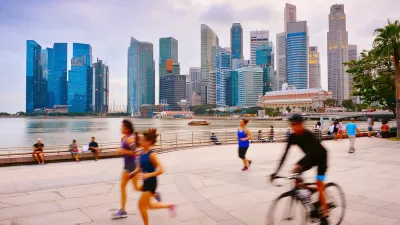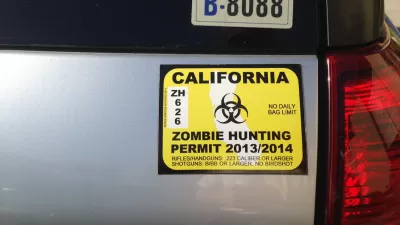New Yorkers can expect to live eight years longer than they could just 20 years ago. Do Mayor Bloomberg's policies and initiatives deserve some credit? A mounting body of evidence ties urban form to human health.
Oliver Balch reports on the mounting ways in which public officials are promoting policies that recognize the link between the built environment and public health. "For Johanna Ralston, chief executive of the World Heart Federation (WHF), the example of New York provides a stellar case of 'retrofitting' a city to make it more heart-healthy. She points to numerous public health interventions introduced under Mayor Michael Bloomberg: a ban on smoking in public places, new bicycle routes, calorie labels on restaurant menus, advertising campaigns around the benefits of taking exercise, to name just a few. 'This all helps build the body of evidence about what an important platform cities can be', she states."
The dangers of smoking are now widely recognized, but what about the dangers of auto-centric lifestyles? "A recent study by the London School of Economics finds that people are likely to live longer in cities like Tokyo, Singapore and Hong Kong, where public transport and walking are favoured over private car use....The findings suggest urban form is a 'contributing factor' to human health, says Ricky Burdett, director of the LSE Cities programme: 'One can begin at least to speculate that these correlations are not just to do with where people of different education or income come from, but that their physical conditions will affect their wellbeing and health.'"
The responsibility to respond to this body of knowledge shouldn't fall solely on the public sector, says Balch. "House builders, infrastructure providers and architects are clearly best placed to take direct action in how our cities are designed. More joined-up thinking is required, says Martin Hunt, head of networks and partnerships for Forum for the Future."
"Take London, he says. The UK capital is currently suffering a housing shortage. 'We want to build homes, but we want to build them in the right way. That requires green space, the ability to exercise and move around freely and safely, and being in an environment that's well-lit, car-free and with good access to public transport', he states."
As Angie Schmitt reports in Streetsblog, the Blue Zones Project, which is run by Healthways, in partnership with AARP, Wellmark Blue Cross Blue Shield, and the Walkable and Livable Communities Institute, is one such example of the private and non-profit sectors driving the design of places that encourage physical activity and social interaction. "More than a dozen places, from the Los Angeles suburbs to small-town Iowa, have been designated as “Blue Zone” communities," notes Schmitt. "The partnership is helping these places advance complete streets, walking school buses, and safe routes to school. The program also focuses on goals like gardening, volunteering, smoking cessation, and providing access to fresh food."
"Blue Zones matches up communities with the Walkable and Livable Communities Institute to help make their infrastructure conducive to healthy living and physical activity, by shifting the focus from designing for autos to designing for walking and social interaction."
FULL STORY: How we can improve the impact of urban living on health and wellbeing

Maui's Vacation Rental Debate Turns Ugly
Verbal attacks, misinformation campaigns and fistfights plague a high-stakes debate to convert thousands of vacation rentals into long-term housing.

Planetizen Federal Action Tracker
A weekly monitor of how Trump’s orders and actions are impacting planners and planning in America.

In Urban Planning, AI Prompting Could be the New Design Thinking
Creativity has long been key to great urban design. What if we see AI as our new creative partner?

King County Supportive Housing Program Offers Hope for Unhoused Residents
The county is taking a ‘Housing First’ approach that prioritizes getting people into housing, then offering wraparound supportive services.

Researchers Use AI to Get Clearer Picture of US Housing
Analysts are using artificial intelligence to supercharge their research by allowing them to comb through data faster. Though these AI tools can be error prone, they save time and housing researchers are optimistic about the future.

Making Shared Micromobility More Inclusive
Cities and shared mobility system operators can do more to include people with disabilities in planning and operations, per a new report.
Urban Design for Planners 1: Software Tools
This six-course series explores essential urban design concepts using open source software and equips planners with the tools they need to participate fully in the urban design process.
Planning for Universal Design
Learn the tools for implementing Universal Design in planning regulations.
planning NEXT
Appalachian Highlands Housing Partners
Mpact (founded as Rail~Volution)
City of Camden Redevelopment Agency
City of Astoria
City of Portland
City of Laramie





























